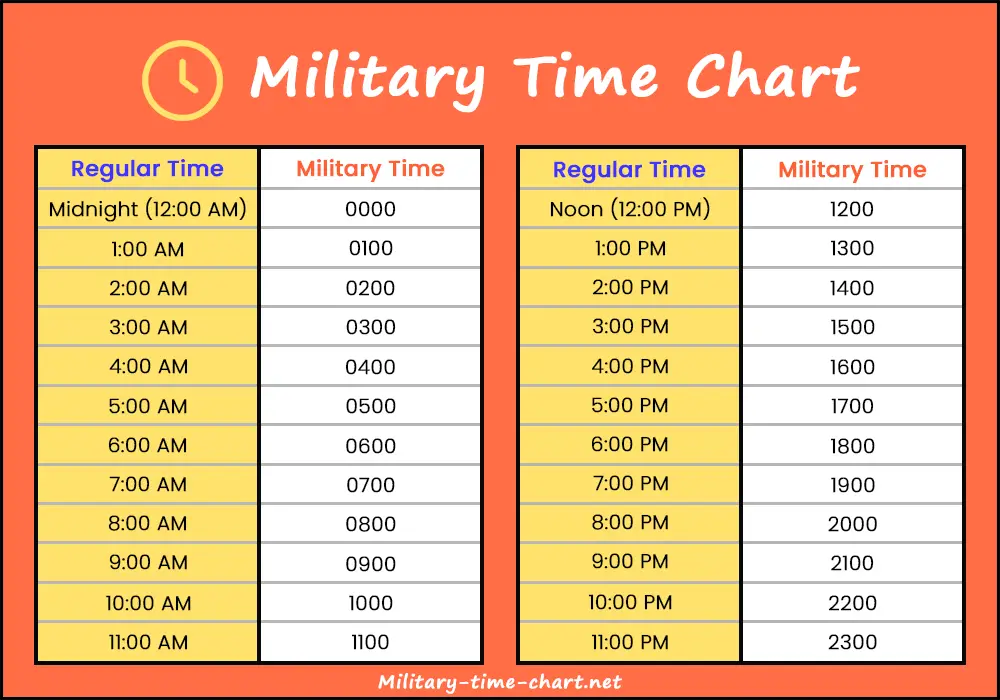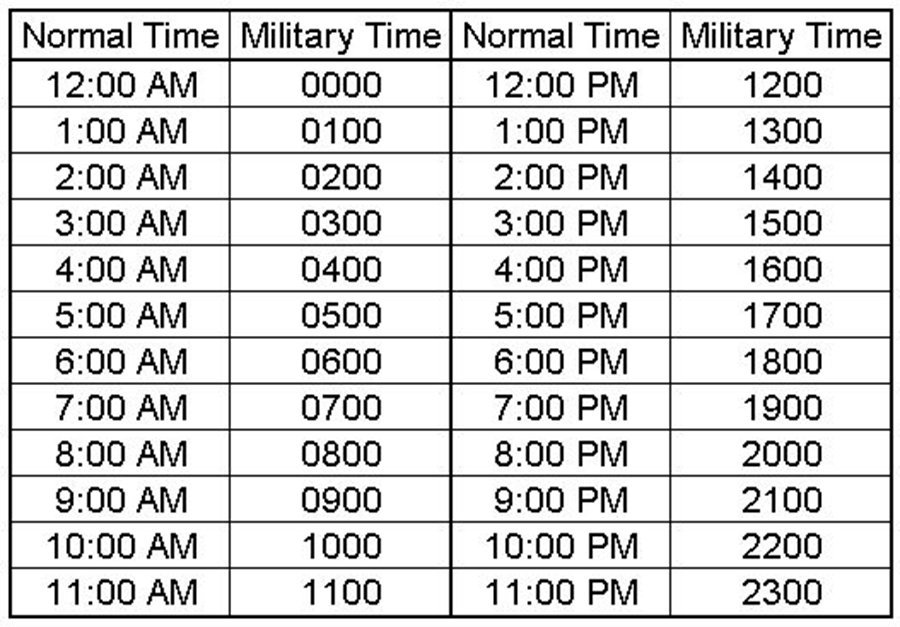Mastering The 2000 Military Time: A Comprehensive Guide For All
Military time, an intriguing 24-hour clock system, is used worldwide for precision and clarity. Among its many formats, the 2000 military time stands out as a key point that signifies 8:00 PM in the standard 12-hour clock system. Understanding this format is essential for professions like the military, aviation, and healthcare, where time accuracy is paramount. By mastering 2000 military time, you can synchronize your activities with global standards, ensuring seamless communication and operation.
For many, the transition from the familiar 12-hour clock to the 24-hour military time can be confusing. It requires a shift in thinking, as there is no AM or PM to distinguish the time of day. However, once you grasp the basics, the system's logic and simplicity become apparent. In this guide, we will delve deep into the 2000 military time, exploring its significance, how it is used, and why it is preferred in various sectors. Whether you're a student, a professional, or simply curious, this comprehensive guide will equip you with the knowledge to navigate military time with ease.
Throughout this article, we will address common questions, provide detailed explanations, and offer practical tips on using military time effectively. From understanding the historical context of military time to its modern-day applications, you will gain a thorough understanding of its importance. Additionally, we will discuss how cultural variations impact the perception and usage of military time across different regions. Let's embark on this enlightening journey to master the 2000 military time, ensuring you are well-prepared for any time-related challenges.
- Unveiling The Impact Of Anjali Arora Mms Sex Controversy
- Aditi Mistry Video Insights And Impact In The Digital World
Table of Contents
- What is 2000 Military Time?
- How to Convert 2000 Military Time?
- Historical Background of Military Time
- Why Use Military Time?
- 2000 Military Time in Daily Life
- Military Time in Professional Settings
- Cultural Perspectives on Military Time
- Advantages of 2000 Military Time
- Common Mistakes with Military Time
- How to Teach Military Time to Children?
- Tools and Resources for Military Time
- FAQ about 2000 Military Time
- Conclusion
- External Resources
What is 2000 Military Time?
2000 military time is a representation of 8:00 PM in the 24-hour clock system commonly used by the military and various industries worldwide. This format eliminates the ambiguity of AM and PM, offering a clear and straightforward way to express time. The 24-hour clock runs from 0000, which is midnight, to 2359, which is one minute before midnight, making 2000 exactly eight hours into the evening.
In this system, each hour is expressed as a four-digit number without any punctuation. The first two digits represent the hour, while the last two indicate the minutes. For example, 2000 means 20 hours and 0 minutes past midnight or 8:00 PM. Understanding 2000 military time is crucial for accurate timekeeping and communication, especially in environments where precision is vital.
How to Convert 2000 Military Time?
Converting 2000 military time to the 12-hour clock format is a simple process once you understand the fundamentals of the 24-hour system. To convert military time to standard time:
- Telugu Sex Films A Dive Into The Controversial Cinematic Genre
- Movierulz Your Ultimate Guide To Online Movie Streaming
- If the hour is greater than 12, subtract 12 from the hour and add PM.
- If the hour is less than 12, simply add AM.
In the case of 2000, subtracting 12 from 20 gives you 8, hence 8:00 PM. This conversion method helps avoid confusion and ensures you can switch between time formats effortlessly.
Historical Background of Military Time
The use of the 24-hour clock dates back centuries, with roots in ancient civilizations. However, its modern adoption as military time began during the 19th century. As military operations became more complex, the need for a precise and universally understood time system emerged. The 24-hour format was adopted to prevent miscommunication and ensure that operations were synchronized across different time zones.
Over time, military time became the standard in various fields beyond the armed forces. Industries such as aviation, logistics, and healthcare adopted this format for its clarity and efficiency. Today, military time is recognized globally, providing a common language for professionals who require exactness in timekeeping.
Why Use Military Time?
Military time offers several advantages over the traditional 12-hour clock. Its primary benefit is the elimination of confusion between AM and PM, which is crucial in situations where even a minor error in time interpretation can lead to significant consequences. Here are some reasons why military time is preferred:
- Reduces errors in scheduling and communication
- Facilitates international operations by standardizing time expressions
- Enhances efficiency in time-sensitive environments
- Improves coordination across different time zones
By adopting military time, organizations can enhance their operational accuracy and ensure that all personnel are literally on the same page when it comes to timekeeping.
2000 Military Time in Daily Life
While military time is predominantly used in professional settings, its application in daily life is becoming increasingly common. Individuals who work in industries like healthcare, aviation, and emergency services often use military time for personal activities to maintain consistency. Moreover, technological devices, such as smartphones and computers, often offer the option to display time in the 24-hour format.
Using military time in daily life can improve time management skills and prevent scheduling mishaps. For instance, planning evening activities like dinners or meetings becomes straightforward when using 2000 military time, as there is no room for misinterpretation. By integrating military time into everyday routines, individuals can enhance their punctuality and reliability.
Military Time in Professional Settings
In professional settings, especially those that operate around the clock, military time is the standard for scheduling and communication. Industries such as:
- Aviation: Flight schedules and crew shifts rely on military time for precision.
- Healthcare: Hospitals use military time for patient records and medication administration.
- Logistics: Shipping and delivery services schedule operations using the 24-hour clock.
- Emergency Services: Police, fire departments, and ambulance services operate on military time for quick response coordination.
These industries use military time to ensure that all operations are synchronized and that there is no confusion regarding time-sensitive tasks. The universal nature of military time aids in seamless communication across borders and time zones.
Cultural Perspectives on Military Time
Cultural attitudes towards military time vary significantly across the globe. In many European and Asian countries, the 24-hour clock is the norm for both personal and professional use. However, in regions like North America, the 12-hour clock is more prevalent for everyday use, with military time reserved for specific sectors.
The perception of military time is often influenced by cultural norms and historical practices. For example, countries with a strong military presence may have a more widespread acceptance of the 24-hour clock. Understanding these cultural perspectives is essential for effective communication in international contexts, where different time formats may be in use.
Advantages of 2000 Military Time
The adoption of 2000 military time and the broader 24-hour clock system brings numerous benefits, particularly in terms of clarity and efficiency:
- Eliminates ambiguity by providing a clear distinction between day and night hours.
- Enhances communication by using a universal time format.
- Facilitates planning and coordination in international and multicultural environments.
- Improves accuracy in record-keeping and operational logistics.
These advantages underscore the importance of military time in various fields, making it a valuable tool for ensuring precision and reliability in time-related tasks.
Common Mistakes with Military Time
Despite its simplicity, military time can still lead to errors if not properly understood. Here are some common mistakes to avoid:
- Misinterpreting the hour: Remember that 13:00 is 1:00 PM, not 13:00 AM.
- Confusing midnight and noon: 0000 is midnight, while 1200 is noon.
- Forgetting to convert minutes: Ensure minutes are accurately represented in the conversion.
- Mixing up AM and PM: Military time does not use these designations; it's all about the numbers.
Avoiding these pitfalls requires practice and familiarity with the 24-hour clock, ensuring that you can use military time confidently and accurately.
How to Teach Military Time to Children?
Introducing children to military time can be a rewarding experience that enhances their understanding of time concepts. Here are some tips on how to teach military time effectively:
- Start with the basics: Explain the difference between the 12-hour and 24-hour clocks.
- Use visual aids: Clocks and charts can help illustrate the concept.
- Practice daily: Incorporate military time into daily routines and activities.
- Make it fun: Use games and quizzes to reinforce learning.
By engaging children in learning about military time, you can help them develop valuable skills that will serve them well in future academic and professional pursuits.
Tools and Resources for Military Time
Several tools and resources are available to assist individuals in mastering military time. These include:
- Conversion apps: Mobile applications that convert standard time to military time and vice versa.
- Online tutorials: Videos and articles that provide step-by-step explanations.
- Printable charts: Visual aids that can be used for quick reference.
- Interactive websites: Platforms that offer quizzes and exercises for practice.
Utilizing these resources can enhance your understanding of military time and ensure you are well-prepared to use it effectively in various contexts.
FAQ about 2000 Military Time
What is 2000 military time?
2000 military time refers to 8:00 PM in the 24-hour clock system. It is a precise way to express evening time, eliminating any confusion associated with AM and PM.
How do I convert 2000 military time to standard time?
To convert 2000 military time to standard time, subtract 12 from the hour if it is greater than 12 and add PM. For 2000, this means 8:00 PM.
Why is military time used?
Military time is used for its precision and clarity. It reduces errors in communication and scheduling, making it ideal for industries where time accuracy is crucial.
What are common mistakes when using military time?
Common mistakes include misinterpreting the hour, confusing midnight and noon, and failing to correctly convert minutes. Familiarity with the 24-hour clock can help avoid these errors.
How can I teach military time to children?
Teaching military time to children involves explaining the basics, using visual aids, practicing regularly, and incorporating fun activities like games and quizzes.
Where can I find resources to learn military time?
Resources for learning military time include conversion apps, online tutorials, printable charts, and interactive websites that offer practice exercises and quizzes.
Conclusion
Mastering 2000 military time and the broader 24-hour clock system is a valuable skill that enhances precision and clarity in timekeeping. Whether used in professional settings or daily life, military time offers numerous advantages, such as eliminating ambiguity, improving communication, and facilitating international operations. By understanding its principles and applications, individuals can ensure accurate and efficient time management.
External Resources
For further information on military time and its applications, consider exploring the following external resources:
- Time and Date: A comprehensive resource for learning about different time systems.
- World Clock: Offers a global perspective on time zones and formats.
- Intriguing Insights Into Sophie Rain Leaks A Comprehensive Overview
- The Buzz Around Viral Mms Insights And Impacts

Military Time Chart 24Hour Clock

Military Time The U.S. Army